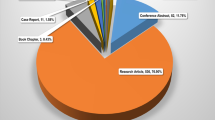Abstract
Peer review is the most important aspect of reputable journals. Without it, we would be unsure about whether the material published was as valid and reliable as is possible. However, with the advent of the Internet, scientific literature has now become subject to a relatively new phenomenon: fake peer reviews. Some dishonest researchers have been manipulating the peer review process to publish what are often inferior papers. There are even papers that explain how to do it. This paper discusses one of those methods and how editors can defeat it by using a special review ID. This method is easy to understand and can be added to current peer review systems easily.




Similar content being viewed by others
References
Basnet, R. B., Mukkamala, S., & Sung, A. H. (2008). Detection of phishing attacks: A machine learning approach. Soft Computing Applications in Industry, 226, 373–383.
Beall, J. (2016). Dangerous predatory publishers threaten medical research. Journal of Korean Medical Science, 31(10), 1511–1513. doi:10.3346/jkms.2016.31.10.1511.
Dadkhah, M., & Bianciardi, G. (2016). Hackers spy scientists. Indian Pediatrics, 53(11), 1027.
Dadkhah, M., Lagzian, M., & Borchardt, G. (2017). Identity theft in the academic world leads to junk science. Science and Engineering Ethics. doi:10.1007/s11948-016-9867-x.
Dileep Kumar, J., Srikanth, V., & Tejeswini, L. (2016). Email phishing attack mitigation using server side email addon. Indian Journal of Science & Technology, 9(19), 1–5. doi:10.17485/ijst/2016/v9i19/91161.
Dinev, T. (2006). Why spoofing is serious internet fraud. Communications of the ACM, 49(10), 76–82. doi:10.1145/1164394.1164398.
Hamid, I. R. A., Abawajy, J., & Kim, T.-H. (2013). Using feature selection and classification scheme for automating phishing email detection. Studies in Informatics and Control, 22(1), 61–70.
Haug, C. J. (2015). Peer-review fraud—hacking the scientific publication process. New England Journal of Medicine, 373(25), 2393–2395. doi:10.1056/NEJMp1512330.
Rao, R. S., & Ali, S. T. (2015). A computer vision technique to detect phishing attacks. In Paper presented at the communication systems and network technologies (CSNT), 2015 fifth international conference on.
Resnik, D. B., & Elmore, S. A. (2016). Ensuring the quality, fairness, and integrity of journal peer review: A possible role of editors. Science and Engineering Ethics, 22(1), 169–188. doi:10.1007/s11948-015-9625-5.
Teixeira da Silva, J. A., & Al-Khatib, A. (2017). Should authors be requested to suggest peer reviewers? Science and Engineering Ethics. doi:10.1007/s11948-016-9842-6.
Author information
Authors and Affiliations
Corresponding author
Ethics declarations
Conflict of interest
None
Rights and permissions
About this article
Cite this article
Dadkhah, M., Kahani, M. & Borchardt, G. A Method for Improving the Integrity of Peer Review. Sci Eng Ethics 24, 1603–1610 (2018). https://doi.org/10.1007/s11948-017-9960-9
Received:
Accepted:
Published:
Issue Date:
DOI: https://doi.org/10.1007/s11948-017-9960-9




